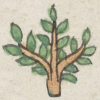Huexotzinco (Mdz42r)
This compound glyph for the place name Huexotzinco doubles as the ethnic name, Huexotzincatl (as shown in the gloss image). The glyph includes two elements, a tree known as a white willow (huexotl) and a buttocks or bottom [tzintli used here to provide the phonetic value for the locative suffix (-tzinco), place. The tree is a two-tone green. It has a leader and two side branches. The bottom is of a male (with the white waist band of the loincloth visible), the skin tone is a terracotta, and the lower half of the body is in a profile view with the man facing to the viewer's right. The head of a man (not shown here but attached to the place name on folio 42 recto) has short hair just below his ears, bangs, a headband, and a curved labret covering his chin, which Berdan and Anawalt say are all features typical of men from this town.
Stephanie Wood
This huexotl compares favorably and differs from others in the Codex Mendoza, as can be seen below, right. Huexotzinco (or Huejotzingo today) is located in the contemporary state of Puebla.
Stephanie Wood
huexotzincatl
Huexotzincatl
Stephanie Wood
by 1553 at the latest
Stephanie Wood
trees, árboles, rear end, nalgas

huexo(tl), white willow tree, https://nahuatl.wired-humanities.org/content/huexotl
tzin(tli), buttocks, bottom, rear end, https://nahuatl.wired-humanities.org/content/tzintli
-tzinco (locative suffix), little, lower, or new, https://nahuatl.wired-humanities.org/content/tzinco
"New Huexotlah" [Frances Karttunen, unpublished manuscript, used here with her permission.]
"On the Small Willow Tree" (Berdan and Anawalt, 1992, vol. 1, p. 188)
Codex Mendoza, folio 42 recto, https://codicemendoza.inah.gob.mx/inicio.php?lang=english
The Bodleian Libraries, University of Oxford, hold the original manuscript, the MS. Arch. Selden. A. 1. This image is published here under the UK Creative Commons, “Attribution-NonCommercial-ShareAlike 3.0 License” (CC-BY-NC-SA 3.0).






